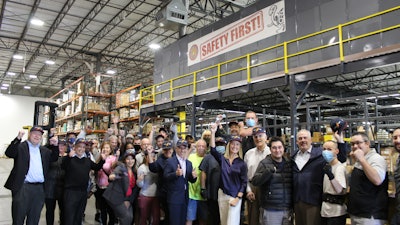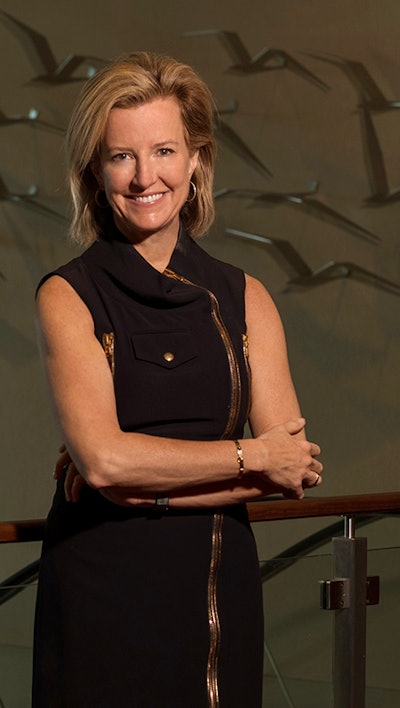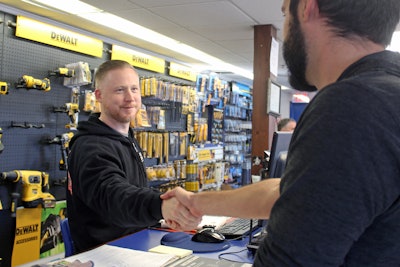
Over the past few years, pressure from legislators, stockholders and consumers has influenced business organizations large and small to take a hard look at their sustainability goals. For many, the results have been ambitious pledges to target their carbon footprints through energy reduction goals.
But the proclamations are one thing; achieving them is another.
Linden, New Jersey-based Turtle & Hughes has long held a role as a key supplier to companies in a variety of industries, balancing an industrial and electrical product line with integrated supply, technical expertise and a vast array of services.
First established in 1923, Turtle & Hughes has spent decades developing its capabilities around sustainable business solutions, so when the industry’s momentum began to shift towards more targeted, trackable efforts on sustainability, the company was ready – and willing – to help support it.
 Jayne Millard, Turtle & Hughes chairmanTurtle & Hughes
Jayne Millard, Turtle & Hughes chairmanTurtle & Hughes
Saving the Earth, One Project at a Time
With a high bar to reach, what do these innovative relationships look like? Turtle’s team has taken an aggressive approach to solving challenges relating to carbon footprint reduction, a strategy CEO Kathleen Shanahan calls “purpose-driven.”
Efforts include supporting the use of clean energy via EV charging solutions and systems equipment for solar installations. Turtle has also helped reduce greenhouse gas emissions for customers through infrastructure upgrades to efficient lighting, power distribution systems and more. Last year, the company even launched a catalog focused entirely on products with a green, sustainable return.
But it goes beyond just availability. Anyone can offer the equipment, but where Turtle really stands out is its experience solving complex problems in the marketplace. Customers who need it, therefore, are able to rely heavily on Turtle’s expertise as they try to navigate new territory. Luis Valls, president of the Electrical Distribution division for Turtle, describes the opportunities these customers have to leverage Turtle’s experts in “multiple disciplines, such as energy efficiency, solar, wind, energy storage and electrification solutions.” Investments in internal technical expertise provide a leg up and a full-scope approach, starting with design assistance and extending through the project management and execution stages of a customer’s energy transition projects.
And the role that sustainability plays in these customer applications continues to grow. According to Valls, about 70% of current customer projects contain a sustainability component, primarily aimed at reducing greenhouse gas emissions or supporting the use of clean energy overall. “So that gives you a little concept of what we do in helping our customer achieve their sustainability goals,” says Valls.
Walking the Walk
But there’s more to the story than customer needs. Supporting all this is the company’s own commitment to ESG, as outlined in Turtle’s 2022 ESG report, which was released in October.
Its goals, says Turtle, face not just outward but inward as well. Impacts to its own operations have included two solar arrays that produced a combined 573,621 Kwh between 2021 and 2022 alone. Turtle notes the benefits of remote and hybrid working, and says 56% percent of its workforce has the flexibility to do so. Add in cuts to air travel, which the company says scrapped 102 tons of carbon emissions from its business operations, and you can see how Turtle is getting serious about doing this the right way.
 Kathleen Shanahan, Turtle & Hughes CEOTurtle & Hughes
Kathleen Shanahan, Turtle & Hughes CEOTurtle & Hughes
Valls adds that ESG goes beyond the company’s four walls, and that new and existing customers “are demanding to do business with people that have ESG goals and ESG plans.”
Shanahan notes that there are key benefits to Turtle as well: “I think the employees have seen, especially the sales people that are bidding these big projects, the value of the ESG report, because it not only tells our story, but it also tells how we’re trying to get better.”
Independent Thinking
Turtle & Hughes is one of the few distributors of its size that’s remained independent and family-run, and while this path brings challenges, it also offers many opportunities.
Remaining nimble may be a key competitive advantage that comes with independence, most notably as supply chains bear the weight of a disruptive environment. Valls reflects on the current state of just-in-time, and the upheaval that pandemic supply chain strains created for manufacturers.
“They’re struggling with that,” Valls says. “But I think they’re realizing that their supply chain activities have to change, and that just-in-time, in the future, is not going to work anymore.”
For Turtle, this presents an opportunity. As a solution, the company is taking strides to incorporate automation and streamline supply and demand planning with the ability to communicate that to the customers.
Says Valls, “We’re constantly assessing our inventory and analyzing our strengths to be able to anticipate the needs. We’ve been around for a hundred years, so we have strong relationships with our suppliers. This also becomes key in times like this, having these relationships, to help us get through supply chain challenges that we’re experiencing today.”
100 Years of Aptitude
As Valls notes, 100 years of experience – paired with a compelling market strategy and attuned leadership and team members – means Turtle & Hughes sees many more opportunities on the horizon.
Millard, who previously served as CEO before moving to the executive chair role, calls this period of time “exciting” and teases some announcements “about what Turtle is going to be looking like and the new areas of growth we’re committing to.” One of these is in adding more technology solutions, a key pillar of growth that Millard believes enables Turtle “to assist our customers in adapting technology to better suit their needs.”
For Shanahan, helming a company that’s continued to thrive through 100 years of changes in distribution is “a unique honor.” And as challenges persist, the company plans to roll out a fresh strategic plan in order to “get better and faster in response to what our customers need,” Shanahan says.
 In addition to full e-commerce capabilities, Turtle & Hughes customers can shop green products at brick and mortar stores in locations across the country.Turtle & Hughes
In addition to full e-commerce capabilities, Turtle & Hughes customers can shop green products at brick and mortar stores in locations across the country.Turtle & Hughes
Perhaps the care with which company leaders appear to treat the planet, the community and their business partners is what makes the workforce at Turtle feel confident in the company’s core values. Millard works hard to focus on – and bring value to – Turtle’s culture, something that company leaders believe has proven to support employee retention. Among other things, Valls points to programs like “Rising Stars” and “Bright Ideas” that validate the voices and opinions of all team members. Additionally, Shanahan cites “constant communication,” where input from employees helps leaders determine whether they’re on the right track.
For Millard, the COVID-19 pandemic came with some valuable lessons, and despite the tragic backdrop of the virus, it was also a “tremendous learning opportunity in how companies can adjust their priorities.” For Turtle, that meant making sure its employees received the flexibility and support that they needed during that difficult period. Millard says it was important for Turtle to “send the message that we’re here to lift all boats and we’re a family and we support each other.”
The results of that approach has meant a galvanized team with “a wonderful attitude towards the collective and the family culture of the business,” says Millard. “And we can do anything to grow the business, or help people in suffering, if we put our minds to it as a team.























